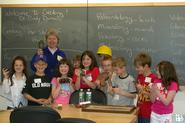
About 70 Seneca Street Elementary School students (Oneida) in grades 3-6 visited Hamilton for a Science Day on June 5. The students completed a reading challenge and this field trip was their reward. The morning began with a presentation by Doug Weldon, the Stone Professor of Psychology. Weldon showed optical illusions and explained how vision is controlled by the brain and why we see images the way we do.
The students then rotated through five more presentations in five different departments. In physics, Director of Laboratories James Schreve did some experiments with light using a ripple tank and a wave machine. The students got to wear special glasses to see the combinations of different colored light that make up white light, such as that from a light bulb. Schreve also explained how the images we see on TV are just different combinations of different colored light (for example, yellow on TV is green and red light).
In geology, Professor of Geosciences Cindy Domack talked about the many different areas of geology and showed the students the tools she and her paleontology students use when working in the field to extract fossils from rock. Domack then showed several fossils from her collection, including a tooth from a shark that lived 40 million years ago and was a much larger relative of the great white shark; a Mastadon tooth; and Eurypterids, the state fossil of New York, which were marine scorpions that grew up to nine feet long and are older than the dinosaurs. The students also looked through a microscope to see an insect preserved in amber.
In chemistry, Professor of Chemistry Karen Brewer did several short experiments. Brewer showed the students that when an inflated balloon is placed in liquid nitrogen the extremely cold temperature turns the air in the balloon to liquid and the balloon becomes smaller; but when it is removed from the liquid nitrogen, the balloon goes back to its original size. Brewer also put a dollar bill soaked in water and alcohol into a flame and explained that the alcohol burns, but then the water extinguishes the flame. The students got to do their own chemical reaction to produce green "goop."
In archaeology, Professor of Archaeology Tom Jones talked about evolution and displayed skulls from different species and early humans. The students compared a skull from Australopithecus Afarensis, an early human that lived 3.2 million year ago, and that of a modern human. The main changes, they learned, are the teeth and jaw, which are much smaller in modern humans because of a significant change in diet; brain size, which is much larger in modern humans; and the position of the limbs to allow modern humans to walk upright.
In biology, Professor of Biology David Gapp talked about adaptations of reptiles, specifically in their methods of feeding. He showed the students two snakes, a corn snake and a boa constrictor, as an example of reptiles that use disarticulation, or separation of the jaw, to swallow their food whole. He also showed a snapping turtle, which has a beak like structure for feeding, and an alligator, which swims with only its eyes and nose above the water to surprise its prey. The highlight for the students was getting to touch the boa constrictor and alligator!
-- by Laura Trubiano '07
Posted June 6, 2006
